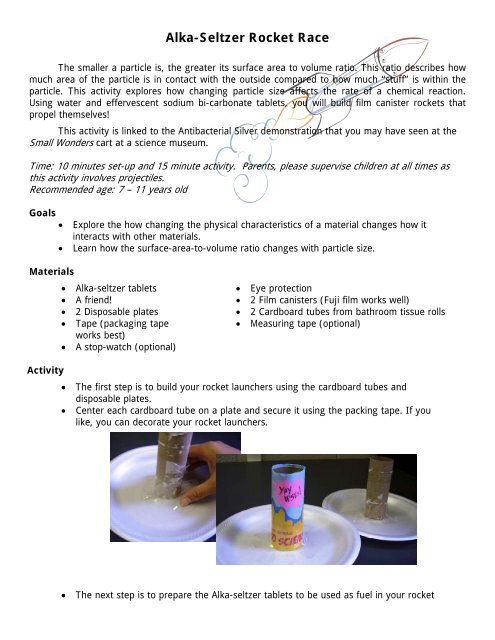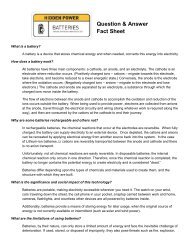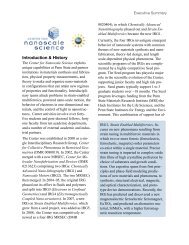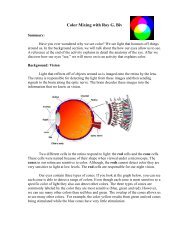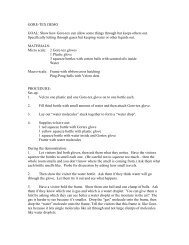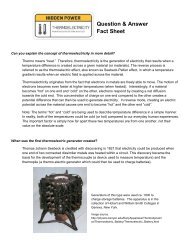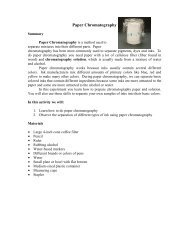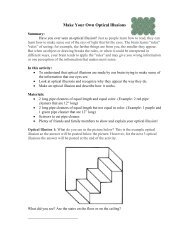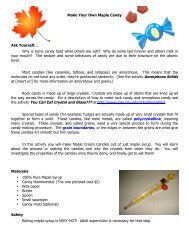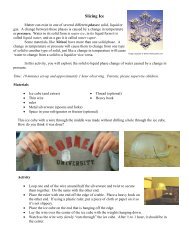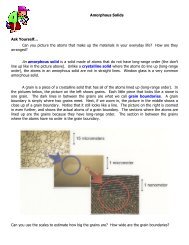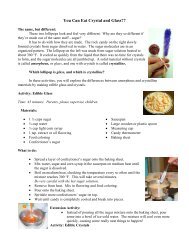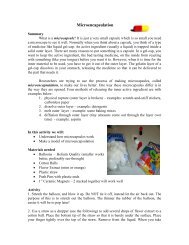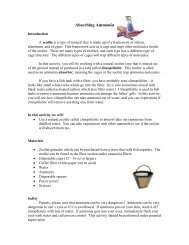Alka-Seltzer Rocket Race - the Center for Nanoscale Science
Alka-Seltzer Rocket Race - the Center for Nanoscale Science
Alka-Seltzer Rocket Race - the Center for Nanoscale Science
Create successful ePaper yourself
Turn your PDF publications into a flip-book with our unique Google optimized e-Paper software.
<strong>Alka</strong>-<strong>Seltzer</strong> <strong>Rocket</strong> <strong>Race</strong><br />
The smaller a particle is, <strong>the</strong> greater its surface area to volume ratio. This ratio describes how<br />
much area of <strong>the</strong> particle is in contact with <strong>the</strong> outside compared to how much “stuff” is within <strong>the</strong><br />
particle. This activity explores how changing particle size affects <strong>the</strong> rate of a chemical reaction.<br />
Using water and effervescent sodium bi-carbonate tablets, you will build film canister rockets that<br />
propel <strong>the</strong>mselves!<br />
This activity is linked to <strong>the</strong> Antibacterial Silver demonstration that you may have seen at <strong>the</strong><br />
Small Wonders cart at a science museum.<br />
Time: 10 minutes set-up and 15 minute activity. Parents, please supervise children at all times as<br />
this activity involves projectiles.<br />
Recommended age: 7 – 11 years old<br />
Goals<br />
Materials<br />
Activity<br />
• Explore <strong>the</strong> how changing <strong>the</strong> physical characteristics of a material changes how it<br />
interacts with o<strong>the</strong>r materials.<br />
• Learn how <strong>the</strong> surface-area-to-volume ratio changes with particle size.<br />
• <strong>Alka</strong>-seltzer tablets<br />
• A friend!<br />
• 2 Disposable plates<br />
• Tape (packaging tape<br />
works best)<br />
• A stop-watch (optional)<br />
• Eye protection<br />
• 2 Film canisters (Fuji film works well)<br />
• 2 Cardboard tubes from bathroom tissue rolls<br />
• Measuring tape (optional)<br />
• The first step is to build your rocket launchers using <strong>the</strong> cardboard tubes and<br />
disposable plates.<br />
• <strong>Center</strong> each cardboard tube on a plate and secure it using <strong>the</strong> packing tape. If you<br />
like, you can decorate your rocket launchers.<br />
• The next step is to prepare <strong>the</strong> <strong>Alka</strong>-seltzer tablets to be used as fuel in your rocket
• Have your parent help you cut or snap <strong>the</strong> tablet into four equal pieces; you will only<br />
need two of <strong>the</strong>se pieces <strong>for</strong> <strong>the</strong> activity.<br />
• Measure equal amounts of water into each empty<br />
film canister so that it is about ½ way filled. It’s<br />
important to keep <strong>the</strong> amount of water equal in<br />
each film canister so that your results are not<br />
affected.<br />
• Between you and your friend,<br />
decide who will crumble up<br />
<strong>the</strong>ir rocket fuel into smaller<br />
pieces and who will use <strong>the</strong><br />
piece of tablet as it is. DO<br />
NOT ADD THE ALKA-SELTZER TABLETS TO THE CANISTERS YET! That will be a later<br />
step.<br />
• Clear your area <strong>for</strong> <strong>the</strong> rocket launch. This means that you need to be wearing your<br />
eye protection, that you are not shooting <strong>the</strong> rockets at or near any o<strong>the</strong>r person, and<br />
that you have all your supplies ready: your cardboard launcher, your <strong>Alka</strong>-seltzer fuel,<br />
your film canister ½ filled with water, and <strong>the</strong> cap to <strong>the</strong> canister.<br />
• Now you are ready to launch your rockets! Try<br />
to guess which rocket will launch faster: <strong>the</strong><br />
person with one big piece of fuel, or <strong>the</strong><br />
person with <strong>the</strong> same amount of fuel, but<br />
crumpled into smaller pieces?<br />
• The last few steps are <strong>the</strong> most complicated<br />
because <strong>the</strong>y must be done very quickly; read<br />
through <strong>the</strong> rest of <strong>the</strong> instructions BEFORE<br />
you start this step. You and your friend need<br />
to put your <strong>Alka</strong>-seltzer tablets into <strong>the</strong> film<br />
canisters at <strong>the</strong> same time.<br />
• Quickly cap <strong>the</strong> film canisters and insert <strong>the</strong>m into <strong>the</strong> launchers cap-side down.<br />
• Aim <strong>the</strong> two launchers away from yourselves and away from anyone else and wait <strong>for</strong><br />
your rockets to launch! Be patient! This step takes up to 1 minute.<br />
• DO NOT LOOK DOWN THE LAUNCHER TO CHECK ON YOUR ROCKET!!! If after several<br />
minutes your rocket doesn’t detonate, tilt <strong>the</strong> launcher away from your face and slide<br />
<strong>the</strong> film canister out onto <strong>the</strong> floor. Hold <strong>the</strong> canister in your hands with <strong>the</strong> cap facing<br />
away from your face and pop it off with your thumbs. Then, try <strong>the</strong> activity again<br />
using 1/3 of an <strong>Alka</strong>-seltzer tablet.<br />
• Whose rocket launched first?<br />
What’s going on?<br />
When <strong>the</strong> <strong>Alka</strong>-seltzer is added to <strong>the</strong> water, <strong>the</strong> tablet dissolves into <strong>the</strong> water and in<br />
<strong>the</strong> process produces a gas called carbon dioxide. When you cap <strong>the</strong> film canister with <strong>the</strong><br />
<strong>Alka</strong>-seltzer and water inside, <strong>the</strong> gas that is produced becomes trapped. As more and more<br />
gas is produced and is trapped, pressure within <strong>the</strong> film canister begins to build. Eventually,
<strong>the</strong> pressure is so great that <strong>the</strong> <strong>for</strong>ce of <strong>the</strong> gas pops open <strong>the</strong> film canister. There is so<br />
much <strong>for</strong>ce that when <strong>the</strong> cap pops off, <strong>the</strong> film canister is shot up into <strong>the</strong> air!<br />
The rocket that used <strong>the</strong> crumpled <strong>Alka</strong>-seltzer as fuel should have launched first.<br />
Although both rockets used <strong>the</strong> same amount of water and <strong>Alka</strong>-seltzer, <strong>the</strong> fuel in this<br />
rocket had a greater surface-area-to-volume ratio. Since <strong>the</strong> gas-producing reaction can only<br />
occur on <strong>the</strong> surface of <strong>the</strong> tablet, this increased ratio means that more gas was produced<br />
more quickly and so <strong>the</strong> pressure increased faster than in <strong>the</strong> large-piece rocket.<br />
Extensions<br />
• Try changing <strong>the</strong> amount or temperature of <strong>the</strong> water that you use; does it make a<br />
difference in how fast <strong>the</strong> rocket will launch? What about <strong>the</strong> distance <strong>the</strong> rocket<br />
travels?<br />
• What if you vary <strong>the</strong> angle when you shoot <strong>the</strong> rocket? What’s <strong>the</strong> best position to<br />
hold <strong>the</strong> launcher so that <strong>the</strong> rocket travels <strong>the</strong> far<strong>the</strong>st distance?<br />
Connection to Nano-Silver<br />
In this activity, you explored how changing <strong>the</strong> particle size of a reactant affected how<br />
it behaved in a reaction. Although you used <strong>the</strong> same amount of <strong>Alka</strong>-seltzer, by changing<br />
its physical <strong>for</strong>m you affected its rate of reaction with water. This caused pressure within <strong>the</strong><br />
film canister to build more quickly and <strong>the</strong> rocket to launch faster.<br />
In products like <strong>the</strong> antibacterial silver food storage containers that you saw at <strong>the</strong><br />
museum, changing <strong>the</strong> particle size of <strong>the</strong> imbedded silver affects its ability to react. Nanosilver<br />
particles are so tiny that <strong>the</strong>ir surface area to volume ratio is very high, making <strong>the</strong>m<br />
extremely effective at preventing bacteria growth. The importance of a high surface-area-tovolume<br />
ratio is not just important <strong>for</strong> nano-silver; it is a fundamental principal of nanoscience<br />
and biological cells!<br />
Vocabulary<br />
Surface area: The total area of <strong>the</strong> surface of a three-dimensional object<br />
Volume: The amount of 3-dimensional space an object occupies or its capacity.<br />
Surface-area-to-volume ratio: The relative size of <strong>the</strong>se two values<br />
Pressure: <strong>for</strong>ce applied over a surface.<br />
References:<br />
<strong>Alka</strong>-<strong>Seltzer</strong>. (2009). Student <strong>Science</strong> Experiments., from http://www.alkaseltzer.com/as/student_experiment.html<br />
Institute of Physics. (2009). <strong>Alka</strong>-seltzer <strong>Rocket</strong>., from http://www.physics.org/interact/physics-to-go/alka-seltzer-rocket/index.html<br />
Math is Fun! (2000). Math Definitions., retrieved May 10, 2009, from http://www.mathsisfun.com/definitions/index.html


